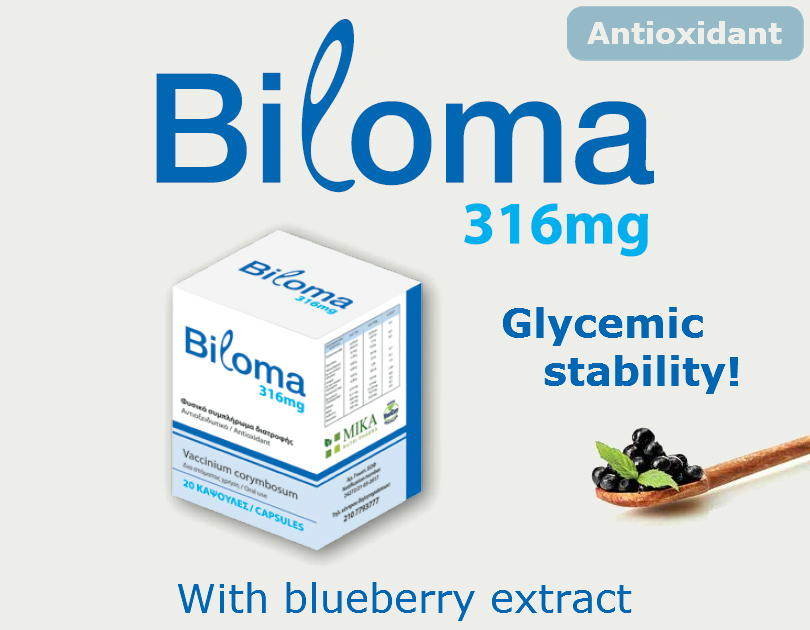
Biloma 316 mg is a new product with blueberry extract (Vaccinium corymbosum), ideal for people with metabolic syndrome. Blueberry has been used over the centuries to deal with a variety of diseases in the form of sputum. It was known in antiquity as “myrtinitis wine” and “myrrhinous oil” and its beneficial properties were associated with the prevention and treatment of inflammation, cardiovascular problems, hyperglycemia and oxidative stress.
A plethora of beneficial ingredients
Blueberry is rich in antioxidant vitamins A, C, E, and beta-carotene, sugars, potassium, magnesium, phosphorus, mineral acids, minerals, pectin and fiber. Its strong antioxidant properties, flavonoids and anthocyanins contained protect against metabolic syndrome and type 2 Diabetes. In particular, anthocyanins have been shown to affect the action of several proteins involved in glucose transport in the body, as well as fat metabolism.
Increased secretion of GLP-1, an ally to the intrinsic antioxidant protection and obesity prevention
Anthocyanins possess antioxidant properties that contribute significantly to the prevention of obesity and insulin resistance. In particular, their antioxidant effects prevent glucose-induced oxidative stress in β-cells in the pancreas, and contribute positively to the growth of GLP-1, the protein that stimulates the secretion of glucose-dependent insulin.
Scientifically documented benefits
According to a study published in the British Medical Journal by researchers from England, USA and Singapore, blueberry reduces the likelihood of Type 2 Diabetes by 26%.
Clinical and epidemiological studies have shown that consumption of flavonoids in foods and beverages can significantly contribute to reducing the risk of developing cardiovascular disease and Type 2 Diabetes. In particular, the consumption of blueberry, rich in anthocyanins, improved insulin resistance, which is a cardiovascular risk factor. In addition, they contribute to lowering blood pressure.
Regulation of intracellular pathways of glucose metabolism
In particular:
- The uptake of anthocyanins in higher amounts was associated with a lower risk of type 2 Diabetes (1).
- The addition of blueberry to diet has led to a significant reduction in glucose, a reduction in total cholesterol, a decrease in LDL-C levels, a VLDL-C and a decrease in triglycerides (2).
- Herbal intake inhibited inflammatory reactions in obese individuals, resulting in increased insulin sensitivity and hence in reducing the risk of developing type 2 Diabetes (3).
- A similar effect was observed in subjects with hypercholesterolemia, through the reduction of inflammatory markers in the arterial endothelium (3).
- It has been demonstrated in vitro and in vivo models that blueberry regulates the intracellular pathways of glucose metabolism (3).
- Nicole M Wedick, et al. Dietary flavonoid intakes and risk of type 2 diabetes in US men and women, American Society for Nutrition (2012).
- Sedigheh Asgary, et. al. Anti-hyperglycemic and anti-hyperlipidemic effects of Vaccinium myrtillus fruit in e Vaccinium myrtillus fruit), Science of Food and Agriculture, 2015.
- Dorothy Klimis-Zacas, et al., Blueberries’ Impact on Insulin Resistance and Glucose Intolerance, Published online 2016 Nov 29. doi: 10.3390/antiox5040044.
